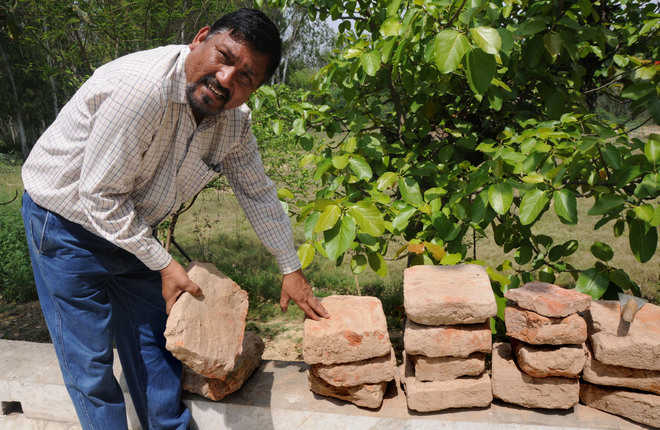Vishal Joshi
Tribune News Service
Nauch (Kaithal), April 8
The chance discovery of ancient structures in the Saraswati wildlife sanctuary here has hinted at more remains of ancient times.
Experts said the Haryana Archaeological Department and the newly formed Saraswati Heritage Development Board should get the area examined for scientific conservation.
The wildlife sanctuary, also known as Seonsar forest, is spread over 45 sq km in Kaithal and Kurukshetra districts.
Rajendra Singh Rana, curator of Kurukshetra’s Srikrishna Museum, told The Tribune, “Prima facie, the remains date back to 1,500 years. These require in-depth study.”
“Members of a dera of Nath yogis in the forest approached us after they spotted certain objects after an ancient banyan tree was uprooted. Bricks emerged from an unknown structure buried more than 15 feet deep,” he said.
Rana further said that as per a popular belief, the Saraswati river used to flow in the area and several religious places and other settlements flourshied on its banks. “It will be interesting to examine the emerging evidence of earlier settlements here.”
Square bricks were associated with the Gupta period 1,500 years ago, the curator said, adding “we found rectangular bricks used during the Kushan period, which was older than the Gupta age. The chance discovery is important, as the remains have been found along the ancient Saraswarti course. It is possible that a civilisation could have flourished along the ancient river”.
The area also has a well made of small lakhauri bricks associated with the Mughal era nearly 400 years ago.
The dera mahant and followers said they would welcome any effort by officials to excavate the site for conservation of the heritage.
Sources in the government, however, said allowing excavation in the forest may jeopardise flora and fauna.
“Seonsar forest that shares boundary with Punjab is home to wildlife such as wild boars, Nilgai, owls, monkeys and snakes. It is one of the major forest patches in the state and excavation in this area will be tricky,” an official said.
Unlock Exclusive Insights with The Tribune Premium
Take your experience further with Premium access.
Thought-provoking Opinions, Expert Analysis, In-depth Insights and other Member Only Benefits
Already a Member? Sign In Now











